Paper Menu >>
Journal Menu >>
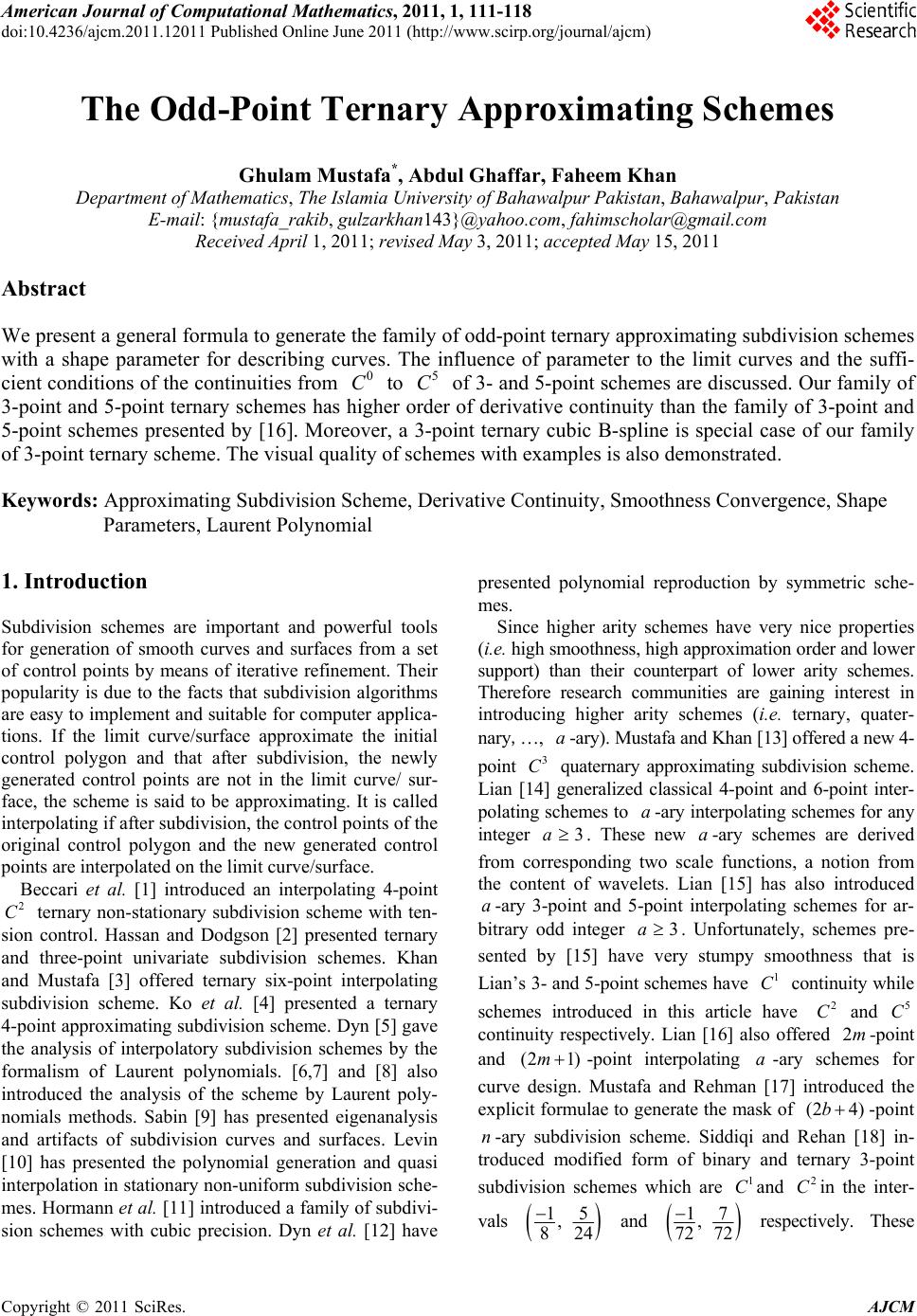 American Journal of Computational Mathematics, 2011, 1, 111-118 doi:10.4236/ajcm.2011.12011 Published Online June 2011 (http://www.scirp.org/journal/ajcm) Copyright © 2011 SciRes. AJCM 111 The Odd-Point Ternary Approximating Schemes Ghulam Mustafa*, Abdul Ghaffar, Faheem Khan Department of Mathematics, The Islamia University of Bahawalpur Pakistan, Bahawalpur, Pakistan E-mail: {mustafa_rakib, gulzarkhan143}@yahoo.com, fahimscholar@gmail.com Received April 1, 2011; revised May 3, 2011; accepted May 15, 2011 Abstract We present a general formula to generate the family of odd-point ternary approximating subdivision schemes with a shape parameter for describing curves. The influence of parameter to the limit curves and the suffi- cient conditions of the continuities from 0 C to 5 C of 3- and 5-point schemes are discussed. Our family of 3-point and 5-point ternary schemes has higher order of derivative continuity than the family of 3-point and 5-point schemes presented by [16]. Moreover, a 3-point ternary cubic B-spline is special case of our family of 3-point ternary scheme. The visual quality of schemes with examples is also demonstrated. Keywords: Approximating Subdivision Scheme, Derivative Continuity, Smoothness Convergence, Shape Parameters, Laurent Polynomial 1. Introduction Subdivision schemes are important and powerful tools for generation of smooth curves and surfaces from a set of control points by means of iterative refinement. Their popularity is due to the facts that subdivision algorithms are easy to implement and suitable for computer applica- tions. If the limit curve/surface approximate the initial control polygon and that after subdivision, the newly generated control points are not in the limit curve/ sur- face, the scheme is said to be approximating. It is called interpolating if after subdivision, the control points of the original control polygon and the new generated control points are interpolated on the limit curve/surface. Beccari et al. [1] introduced an interpolating 4-point 2 C ternary non-stationary subdivision scheme with ten- sion control. Hassan and Dodgson [2] presented ternary and three-point univariate subdivision schemes. Khan and Mustafa [3] offered ternary six-point interpolating subdivision scheme. Ko et al. [4] presented a ternary 4-point approximating subdivision scheme. Dyn [5] gave the analysis of interpolatory subdivision schemes by the formalism of Laurent polynomials. [6,7] and [8] also introduced the analysis of the scheme by Laurent poly- nomials methods. Sabin [9] has presented eigenanalysis and artifacts of subdivision curves and surfaces. Levin [10] has presented the polynomial generation and quasi interpolation in stationary non-uniform subdivision sche- mes. Hormann et al. [11] introduced a family of subdivi- sion schemes with cubic precision. Dyn et al. [12] have presented polynomial reproduction by symmetric sche- mes. Since higher arity schemes have very nice properties (i.e. high smoothness, high approximation order and lower support) than their counterpart of lower arity schemes. Therefore research communities are gaining interest in introducing higher arity schemes (i.e. ternary, quater- nary,…, a-ary). Mustafa and Khan [13] offered a new 4- point 3 C quaternary approximating subdivision scheme. Lian [14] generalized classical 4-point and 6-point inter- polating schemes to a-ary interpolating schemes for any integer 3a. These new a-ary schemes are derived from corresponding two scale functions, a notion from the content of wavelets. Lian [15] has also introduced a-ary 3-point and 5-point interpolating schemes for ar- bitrary odd integer 3a. Unfortunately, schemes pre- sented by [15] have very stumpy smoothness that is Lian’s 3- and 5-point schemes have 1 C continuity while schemes introduced in this article have 2 C and 5 C continuity respectively. Lian [16] also offered 2m-point and (2 1)m -point interpolating a-ary schemes for curve design. Mustafa and Rehman [17] introduced the explicit formulae to generate the mask of (2 4)b -point n-ary subdivision scheme. Siddiqi and Rehan [18] in- troduced modified form of binary and ternary 3-point subdivision schemes which are 1 Cand 2 Cin the inter- vals 5 1, 824 and 7 1, 72 72 respectively. These 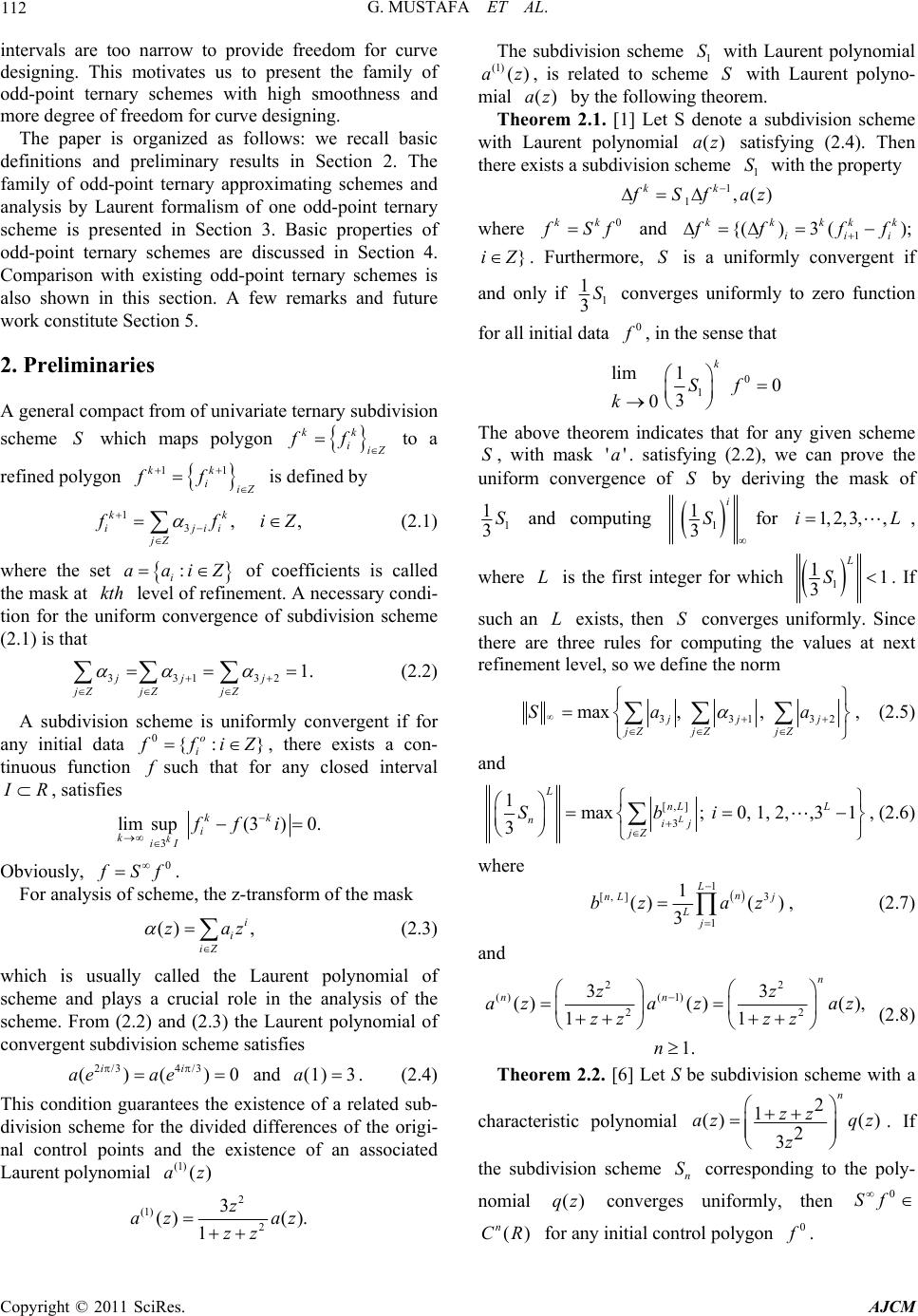 G. MUSTAFA ET AL. Copyright © 2011 SciRes. AJCM 112 intervals are too narrow to provide freedom for curve designing. This motivates us to present the family of odd-point ternary schemes with high smoothness and more degree of freedom for curve designing. The paper is organized as follows: we recall basic definitions and preliminary results in Section 2. The family of odd-point ternary approximating schemes and analysis by Laurent formalism of one odd-point ternary scheme is presented in Section 3. Basic properties of odd-point ternary schemes are discussed in Section 4. Comparison with existing odd-point ternary schemes is also shown in this section. A few remarks and future work constitute Section 5. 2. Preliminaries A general compact from of univariate ternary su bdivision scheme S which maps polygon kk iiZ ff to a refined polygon 11kk iiZ ff is defined by 13, kk ijii jZ f f ,iZ (2.1) where the set : i aaiZ of coefficients is called the mask at kth level of refinement. A necessary condi- tion for the uniform convergence of subdivision scheme (2.1) is that 33132 1. jj j jZ jZjZ (2.2) A subdivision scheme is uniformly convergent if for any initial data 0{:} o i f fiZ, there exists a con- tinuous function f such that for any closed interval I R, satisfies 3 lim sup k kiI (3 ) 0. kk i ffi Obviously, 0 f Sf . For analysis of scheme, the z-transform of the mask () , i i iZ zaz (2.3) which is usually called the Laurent polynomial of scheme and plays a crucial role in the analysis of the scheme. From (2.2) and (2.3) the Laurent polynomial of convergent subdivision scheme satisfies 2/3 4/3 ()()0 ii ae ae and (1) 3a. (2.4) This condition guarantees the existence of a related sub- division scheme for the divided differences of the origi- nal control points and the existence of an associated Laurent polynomial (1)()az 2 (1) 2 3 () (). 1 z az az zz The subdivision scheme 1 S with Laurent polynomial (1) ()az , is related to scheme S with Laurent polyno- mial ()az by the following theorem. Theorem 2.1. [1] Let S denote a subdivision scheme with Laurent polynomial ()az satisfying (2.4). Then there exists a subdivision scheme 1 S with the property 1 1,() kk f Sf az where 0kk f Sf and 1 {()3 (); kkkkk iii f fff }iZ . Furthermore, S is a uniformly convergent if and only if 1 1 3S converges uniformly to zero function for all initial data 0 f , in the sense that lim 0k 0 1 10 3 k Sf The above theorem indicates that for any given scheme S, with mask ''a. satisfying (2.2), we can prove the uniform convergence of S by deriving the mask of 1 1 3S and computing 1 1 3 i S for 1, 2,3,,iL, where L is the first integer for which 1 11 3 L S . If such an L exists, then S converges uniformly. Since there are three rules for computing the values at next refinement level, so we define the norm 33132 max, , jj j jZ jZjZ Sa a , (2.5) and [,] 3 1max; 0, 1, 2,,31 3L L nL L nij jZ Sbi , (2.6) where 1 [, ]3 1 1 ()( ) 3 Ln nL j L j bz az , (2.7) and 22 ()( 1) 22 33 ()() (), 11 1. n nn zz aza zaz zz zz n (2.8) Theorem 2.2. [6] Let S be subdivision scheme with a characteristic polynomial 2 1 () () 2 3 n zz az qz z . If the subdivision scheme n S corresponding to the poly- nomial ()qz converges uniformly, then 0 Sf n CR for any initial control polygon 0 f . 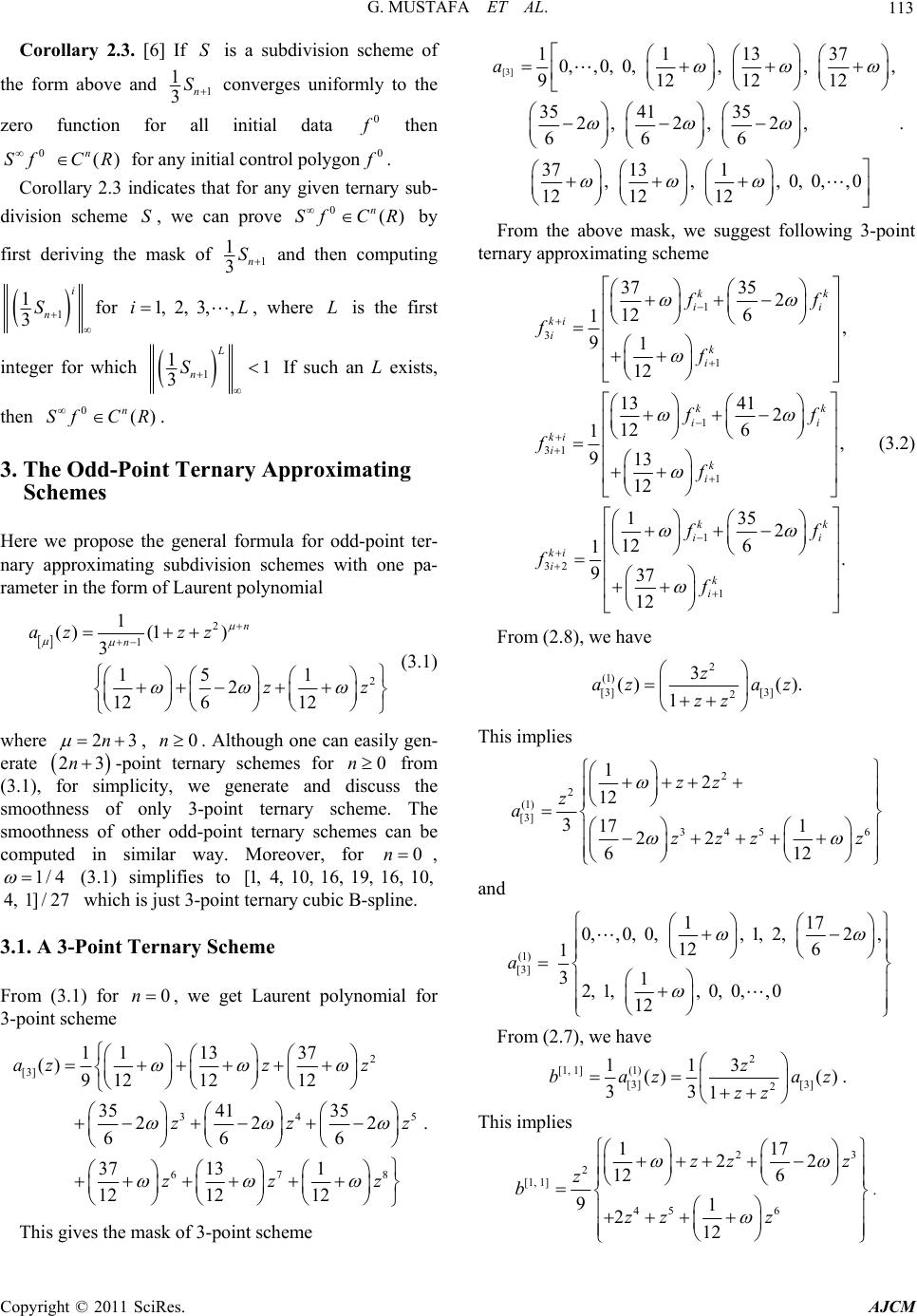 G. MUSTAFA ET AL. Copyright © 2011 SciRes. AJCM 113 Corollary 2.3. [6] If S is a subdivision scheme of the form above and 1 1 3n S converges uniformly to the zero function for all initial data 0 f then 0 n SfC R for any initial control polygon0 f . Corollary 2.3 indicates that for any given ternary sub- division scheme S, we can prove 0() n SfCR by first deriving the mask of 1 1 3n S and then computing 1 1 3 i n S for 1, 2 , 3 ,,iL, where L is the first integer for which 1 11 3 L n S If such an L exists, then 0() n SfC R . 3. The Odd-Point Ternary Approximating Schemes Here we propose the general formula for odd-point ter- nary approximating subdivision schemes with one pa- rameter in the form of Laurent polynomial 2 1 2 1 ()(1 ) 3 15 1 2 12 612 n n az zz zz (3.1) where 23n , 0n. Although one can easily gen- erate 23n-point ternary schemes for 0n from (3.1), for simplicity, we generate and discuss the smoothness of only 3-point ternary scheme. The smoothness of other odd-point ternary schemes can be computed in similar way. Moreover, for 0n , 1/4 (3.1) simplifies to [1, 4, 10, 16, 19, 16, 10, 4, 1 ]/27 which is just 3-point ternary cubic B-spline. 3.1. A 3-Point Ternary Scheme From (3.1) for 0n, we get Laurent polynomial for 3-point scheme 2 [3] 345 678 11 1337 () 912 1212 3541 35 222 666 37 131 12 12 12 azz z zzz zzz . This gives the mask of 3-point scheme [3] 111337 0,,0, 0, , , , 9121212 3541 35 2, 2, 2, 666 37 131 , , , 0, 0,,0 1212 12 a . From the above mask, we suggest following 3-point ternary approximating scheme 1 3 1 1 31 1 1 32 3735 2 12 6 1, 91 12 1341 2 12 6 1, 913 12 135 2 12 6 1 937 12 kk ii ki i k i kk ii ki i k i kk ii ki i f f f f ff f f f f f 1 . k i f (3.2) From (2.8), we have 2 (1) [3] [3] 2 3 () (). 1 z az az zz This implies 2 2 (1) [3] 345 6 12 12 317 1 22 612 zz z a zzz z and (1) [3] 117 0,,0, 0, , 1, 2, 2, 12 6 1 31 2, 1, , 0, 0,,0 12 a From (2.7), we have 2 [1, 1](1) [3] [3] 2 113 () () 33 1 z baz az zz . This implies 23 2 [1, 1] 45 6 117 22 12 6 91 212 zz z z b zz z . 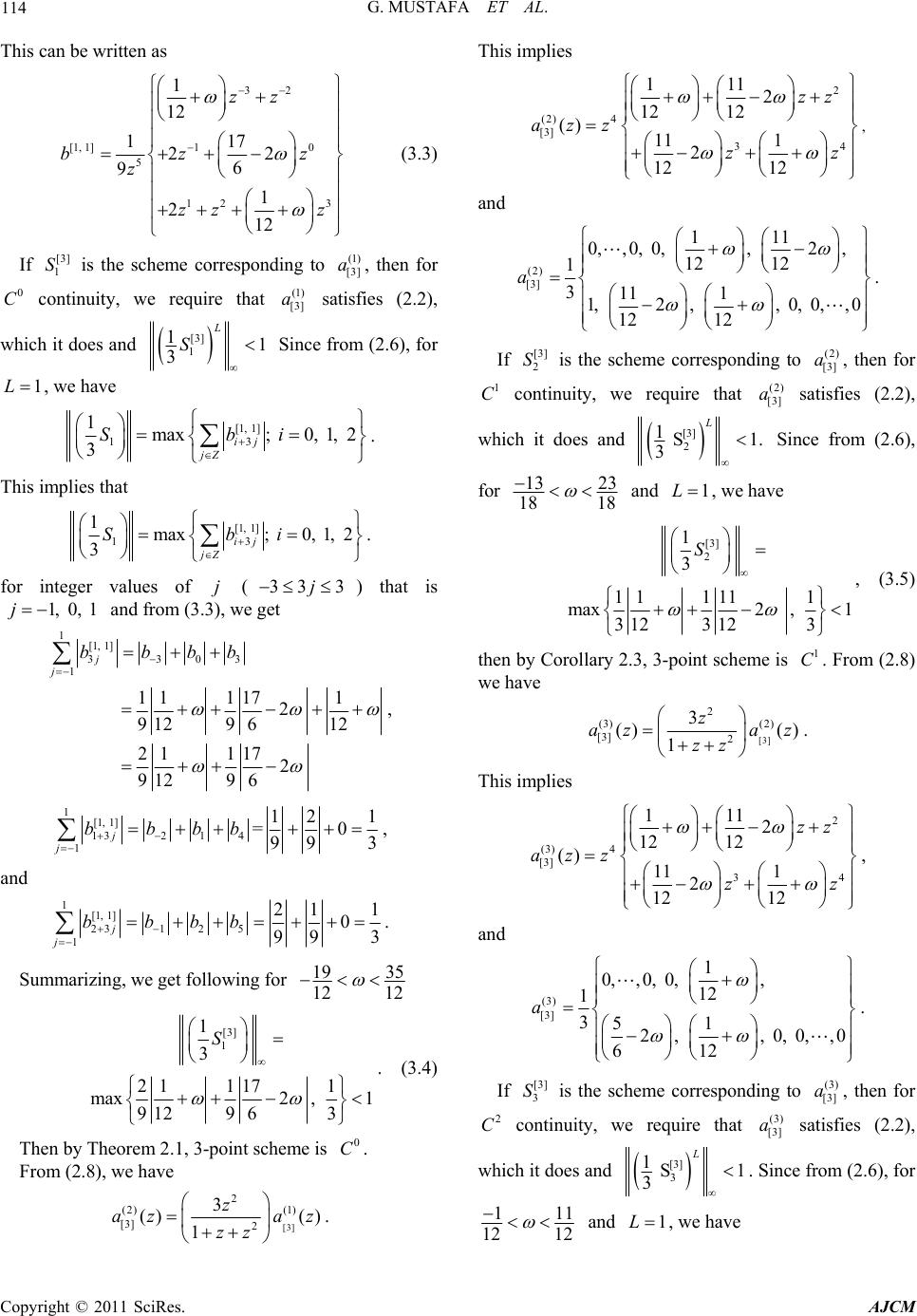 G. MUSTAFA ET AL. Copyright © 2011 SciRes. AJCM 114 This can be written as 32 [1, 1]10 5 12 3 1 12 117 22 6 9 1 212 zz bz z z zz z (3.3) If [3] 1 S is the scheme corresponding to (1) [3] a, then for 0 C continuity, we require that (1) [3] a satisfies (2.2), which it does and [3] 1 11 3 L S Since from (2.6), for 1L, we have [1, 1] 13 1max; 0, 1, 2 3ij jZ Sbi . This implies that [1, 1] 13 1max; 0, 1, 2 3ij jZ Sbi . for integer values of j (33 3j) that is 1, 0 , 1j and from (3.3 ), we get 1[1, 1] 3303 1 11 1171 2 9129 612 21 117 2 9129 6 j j bbbb , 1[1, 1] 132 1 4 1 12 1 =0 993 j j bbbb , and 1[1, 1] 231 2 5 1 211 0 99 3 j j bbbb . Summarizing, we get following for 19 35 12 12 [3] 1 1 3 21 1171 max2, 1 912963 S . (3.4) Then by Theorem 2.1, 3-point scheme is 0 C. From (2.8), we have [3] 2 (2)(1) [3] 2 3 () () 1 z az az zz . This implies 2 (2) 4 [3] 34 111 2 12 12 () 11 1 2 12 12 zz azz zz , and (2) [3] 111 0,,0, 0, , 2, 12 12 1 311 1 1, 2, , 0, 0,,0 12 12 a . If [3] 2 S is the scheme corresponding to (2) [3] a, then for 1 C continuity, we require that (2) [3] a satisfies (2.2), which it does and [3] 2 1S1. 3 L Since from (2.6), for 13 23 18 18 and 1L , we have [3] 2 1 3 11 1111 max2, 1 3123123 S , (3.5) then by Corollary 2.3, 3-point scheme is 1 C. From (2.8) we have [3] 2 (3) (2) [3] 2 3 () () 1 z az az zz . This implies 2 (3) 4 [3] 34 111 2 12 12 () 11 1 2 12 12 zz az z zz , and (3) [3] 1 0,,0, 0, , 12 1 351 2, , 0, 0,,0 612 a . If [3] 3 S is the scheme corresponding to (3) [3] a, then for 2 C continuity, we require that (3) [3] a satisfies (2.2), which it does and [3] 3 1S1 3 L . Since from (2.6), for 111 12 12 and 1L , we have 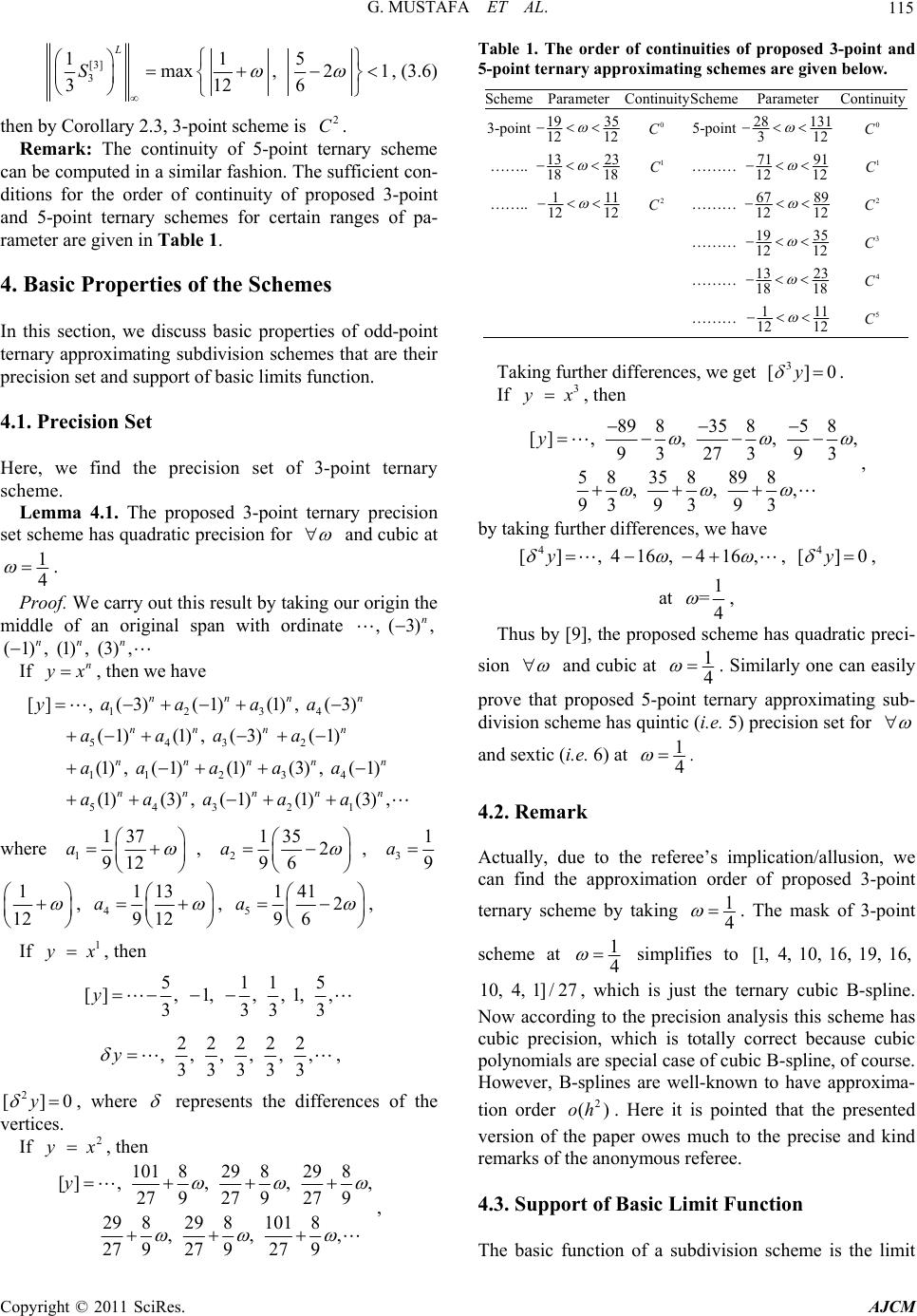 G. MUSTAFA ET AL. Copyright © 2011 SciRes. AJCM 115 [3] 3 115 max, 21 3126 L S , (3.6) then by Corollary 2.3, 3-point scheme is 2 C. Remark: The continuity of 5-point ternary scheme can be computed in a similar fashion. The sufficient con- ditions for the order of continuity of proposed 3-point and 5-point ternary schemes for certain ranges of pa- rameter are given in Table 1. 4. Basic Properties of the Schemes In this section, we discuss basic properties of odd-point ternary approximating subdivision schemes that are their precision set and support of basic limits function. 4.1. Precision Set Here, we find the precision set of 3-point ternary scheme. Lemma 4.1. The proposed 3-point ternary precision set scheme has quadratic precision for and cubic at 1 4 . Proof. We carry out this resu lt by taking ou r origin the middle of an original span with ordinate , (3), n (1), (1), (3), nn n If n y x, then we have 1234 543 2 11234 543 21 [], (3)(1)(1), (3) (1)(1), (3)(1) (1), (1)(1)(3), (1) (1)(3), (1)(1)(3), nnnn nn nn nnnnn nn nnn ya aaa aaa a aaaa a aaa aa where 1137 912 a , 2135 2 96 a , 31 9 a 1 12 , 4113 912 a , 51412 96 a , If 1 y x, then 5115 [], 1, , , 1, , 3333 y 22222 , , , , , , 33333 y , 2 []y , where represents the differences of the vertices. If 2 y x, then 101829 829 8 [], , , , 27927 927 9 29 829 81018 , , , 27 927 9279 y , Table 1. The order of continuities of proposed 3-point and 5-point ternary approximating schemes are given below. Scheme Parameter ContinuityScheme Parameter Continuity 3-point19 35 12 12 0 C 5-point 28 131 312 0 C …….. 1323 18 18 1 C ……… 71 91 12 12 1 C …….. 111 12 12 2 C ……… 6789 12 12 2 C ……… 19 35 12 12 3 C ……… 13 23 18 18 4 C ……… 111 12 12 5 C Takin g further diffe rences, we get 3 [y . If 3 y x, then 898 358 58 [], , , , 93 273 93 58 358898 , , , 939393 y , by taking furth e r differences, we have 4 [, , ,y , 4 [0y , at 1 =4 , Thus by [9], the proposed scheme has quadratic preci- sion and cubic at 1 4 . Similarly one can easily prove that proposed 5-point ternary approximating sub- division scheme has quintic (i.e. 5) precision set for and sextic (i.e. 6) at 1 4 . 4.2. Remark Actually, due to the referee’s implication/allusion, we can find the approximation order of proposed 3-point ternary scheme by taking 1 4 . The mask of 3-point scheme at 1 4 simplifies to [1, 4, 10, 16, 19, 16, 10, 4, 1]/27, which is just the ternary cubic B-spline. Now according to the precision analysis this scheme has cubic precision, which is totally correct because cubic polynomials are special case of cubic B-spline, of course. However, B-splines are well-known to have approxima- tion order 2 ()oh . Here it is pointed that the presented version of the paper owes much to the precise and kind remarks of the anonymous referee. 4.3. Support of Basic Limit Function The basic function of a subdivision scheme is the limit 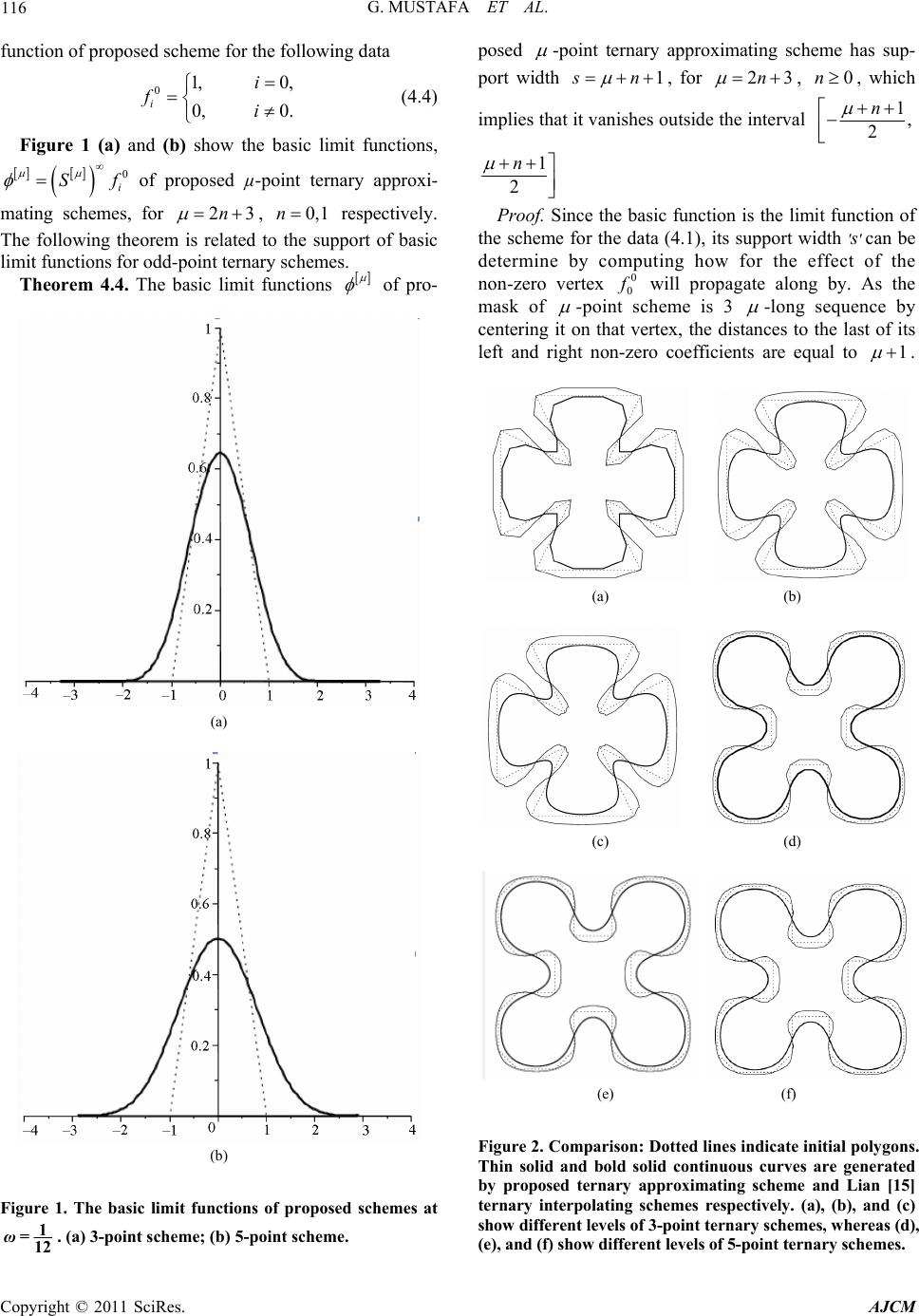 G. MUSTAFA ET AL. Copyright © 2011 SciRes. AJCM 116 function of proposed scheme for the following data 01, 0, 0, 0. i i fi (4.4) Figure 1 (a) and (b) show the basic limit functions, 0 i Sf of proposed µ-point ternary approxi- mating schemes, for 23n , 0,1n respectively. The following theorem is related to the support of basic limit functions for odd-point ternary schemes. Theorem 4.4. The basic limit functions of pro- (a) (b) Figure 1. The basic limit functions of proposed schemes at 1 =12 ω. (a) 3-point scheme; (b) 5-point scheme. posed -point ternary approximating scheme has sup- port width 1 s n , for 23n , 0n, which implies that it vanishes outside th e interval 1, 2 n 1 2 n Proof. Since the basic function is the limit function of the scheme for the data (4.1), its support width ′s′ can be determine by computing how for the effect of the non-zero vertex 0 0 f will propagate along by. As the mask of -point scheme is 3 -long sequence by centering it on that vertex, the distances to the last of its left and right non-zero coefficients are equal to 1 . (a) (b) (c) (d) (e) (f) Figure 2. Comparison: Dotted lines indicate initial polygons. Thin solid and bold solid continuous curves are generated by proposed ternary approximating scheme and Lian [15] ternary interpolating schemes respectively. (a), (b), and (c) show different levels of 3-point ternary schemes, whereas (d), (e), and (f) show different levels of 5-point ternary schemes. 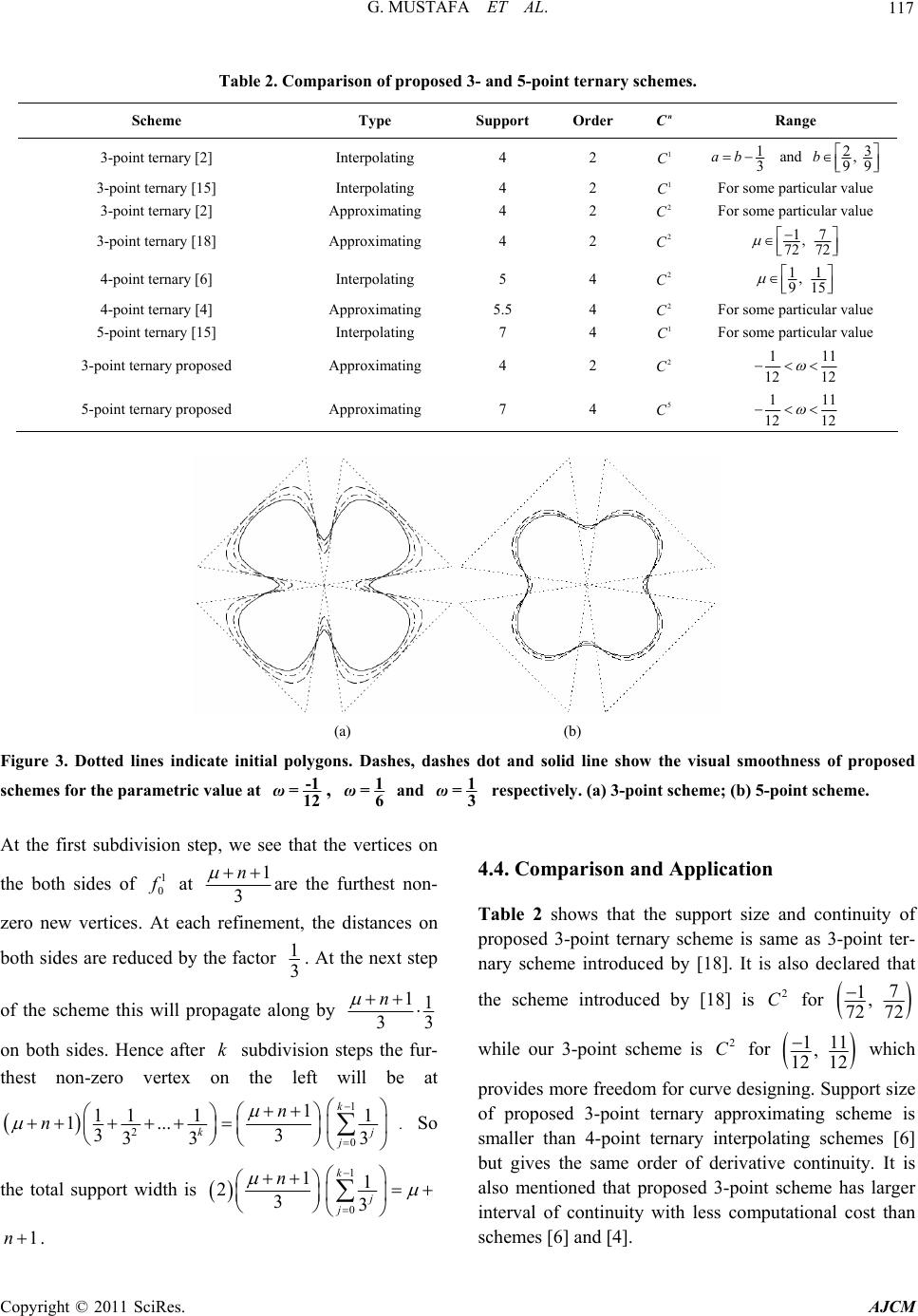 G. MUSTAFA ET AL. Copyright © 2011 SciRes. AJCM 117 Table 2. Comparison of proposed 3- and 5-point ternary schemes. Scheme Type Support Order n C Range 3-point ternary [2] Interpolating 4 2 1 C 1 3 ab and 3 2, 99 b 3-point ternary [15] Interpolating 4 2 1 C For some particular value 3-point ternary [2] Approximating 4 2 2 C For some particular value 3-point ternary [18] Approxi mating 4 2 2 C 7 1, 72 72 4-point ternary [6] Interpolating 5 4 2 C 11 , 915 4-point ternary [4] Approximating 5.5 4 2 C For some particular value 5-point ternary [15] Interpolating 7 4 1 C For some particular value 3-point ternary proposed Approximating 4 2 2 C 111 12 12 5-point terna ry proposed Approximating 7 4 5 C 111 12 12 (a) (b) Figure 3. Dotted lines indicate initial polygons. Dashes, dashes dot and solid line show the visual smoothness of proposed schemes for the parametric value at -1 =12 ω, 1 =6 ω and 1 =3 ω respectively. (a) 3-point scheme; (b) 5-point scheme. At the first subdivision step, we see that the vertices on the both sides of 1 0 f at 1 3 n are the furthest non- zero new vertices. At each refinement, the distances on both sides are reduced by the factor 1 3. At the next step of the scheme this will propagate along by 11 33 n on both sides. Hence after k subdivision steps the fur- thest non-zero vertex on the left will be at 1 20 1 11 11 1 ... 33 33 3 k kj j n n . So the total support width is 1 0 11 233 k j j n 1n. 4.4. Comparison and Application Table 2 shows that the support size and continuity of proposed 3-point ternary scheme is same as 3-point ter- nary scheme introduced by [18]. It is also declared that the scheme introduced by [18] is 2 C for 7 1, 72 72 while our 3-point scheme is 2 C for 111 , 12 12 which provides more freedom for curve designing. Support size of proposed 3-point ternary approximating scheme is smaller than 4-point ternary interpolating schemes [6] but gives the same order of derivative continuity. It is also mentioned that proposed 3-point scheme has larger interval of continuity with less computational cost than schemes [6] and [4]. 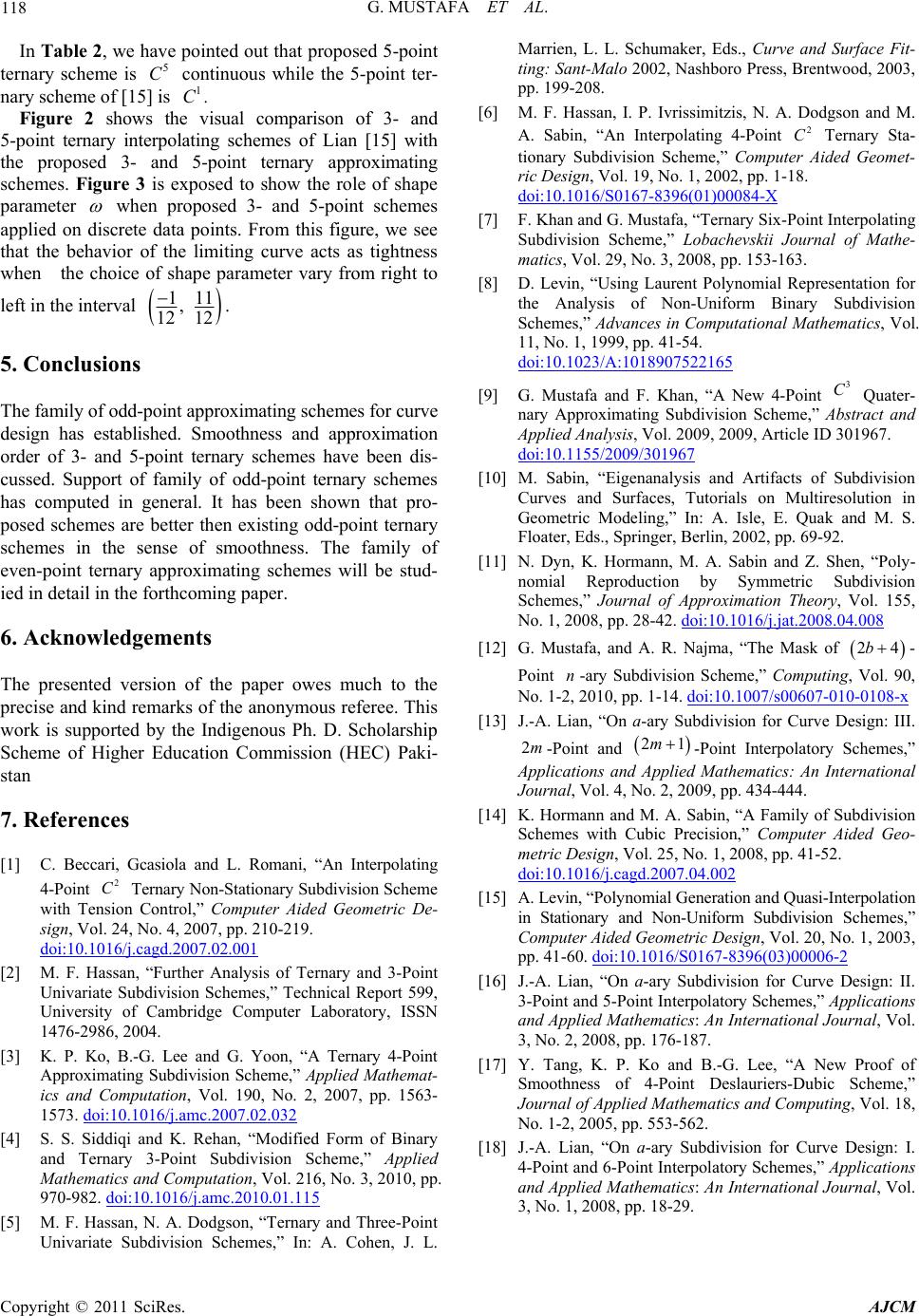 G. MUSTAFA ET AL. Copyright © 2011 SciRes. AJCM 118 In Table 2, we have pointed out that proposed 5-point ternary scheme is 5 C continuous while the 5-point ter- nary scheme of [15] is 1 C. Figure 2 shows the visual comparison of 3- and 5-point ternary interpolating schemes of Lian [15] with the proposed 3- and 5-point ternary approximating schemes. Figure 3 is exposed to show the role of shape parameter when proposed 3- and 5-point schemes applied on discrete data points. From this figure, we see that the behavior of the limiting curve acts as tightness when the choice of shape parameter vary from right to left in the interval 111 , 12 12 . 5. Conclusions The family of odd-point approximating schemes for curve design has established. Smoothness and approximation order of 3- and 5-point ternary schemes have been dis- cussed. Support of family of odd-point ternary schemes has computed in general. It has been shown that pro- posed schemes are better then existing odd-point ternary schemes in the sense of smoothness. The family of even-point ternary approximating schemes will be stud- ied in detail in the forthcoming paper. 6. Acknowledgements The presented version of the paper owes much to the precise and kind remarks of the anonymous referee. This work is supported by the Indigenous Ph. D. Scholarship Scheme of Higher Education Commission (HEC) Paki- stan 7. References [1] C. Beccari, Gcasiola and L. Romani, “An Interpolating 4-Point 2 C Ternary Non-Stationary Subdivision Scheme with Tension Control,” Computer Aided Geometric De- sign, Vol. 24, No. 4, 2007, pp. 210-219. doi:10.1016/j.cagd.2007.02.001 [2] M. F. Hassan, “Further Analysis of Ternary and 3-Point Univariate Subdivision Schemes,” Technical Report 599, University of Cambridge Computer Laboratory, ISSN 1476-2986, 2004. [3] K. P. Ko, B.-G. Lee and G. Yoon, “A Ternary 4-Point Approximating Subdivision Scheme,” Applied Mathemat- ics and Computation, Vol. 190, No. 2, 2007, pp. 1563- 1573. doi:10.1016/j.amc.2007.02.032 [4] S. S. Siddiqi and K. Rehan, “Modified Form of Binary and Ternary 3-Point Subdivision Scheme,” Applied Mathematics and Computation, Vol. 216, No. 3, 2010, pp. 970-982. doi:10.1016/j.amc.2010.01.115 [5] M. F. Hassan, N. A. Dodgson, “Ternary and Three-Point Univariate Subdivision Schemes,” In: A. Cohen, J. L. Marrien, L. L. Schumaker, Eds., Curve and Surface Fit- ting: Sant-Malo 2002, Nashboro Press, Brentwood, 2003, pp. 199-208. [6] M. F. Hassan, I. P. Ivrissimitzis, N. A. Dodgson and M. A. Sabin, “An Interpolating 4-Point 2 C Ternary Sta- tionary Subdivision Scheme,” Computer Aided Geomet- ric Design, Vol. 19, No. 1, 2002, pp. 1-18. doi:10.1016/S0167-8396(01)00084-X [7] F. Khan and G. Mustafa, “Ternary Six-Point Interpolating Subdivision Scheme,” Lobachevskii Journal of Mathe- matics, Vol. 29, No. 3, 2008, pp. 153-163. [8] D. Levin, “Using Laurent Polynomial Representation for the Analysis of Non-Uniform Binary Subdivision Schemes,” Advances in Computational Mathematics, Vol. 11, No. 1, 1999, pp. 41-54. doi:10.1023/A:1018907522165 [9] G. Mustafa and F. Khan, “A New 4-Point 3 C Quater- nary Approximating Subdivision Scheme,” Abstract and Applied Analysis, Vol. 2009, 2009, Article ID 301967. doi:10.1155/2009/301967 [10] M. Sabin, “Eigenanalysis and Artifacts of Subdivision Curves and Surfaces, Tutorials on Multiresolution in Geometric Modeling,” In: A. Isle, E. Quak and M. S. Floater, Eds., Springer, Berlin, 2002, pp. 69-92. [11] N. Dyn, K. Hormann, M. A. Sabin and Z. Shen, “Poly- nomial Reproduction by Symmetric Subdivision Schemes,” Journal of Approximation Theory, Vol. 155, No. 1, 2008, pp. 28-42. doi:10.1016/j.jat.2008.04.008 [12] G. Mustafa, and A. R. Najma, “The Mask of 24b - Point n-ary Subdivision Scheme,” Computing, Vol. 90, No. 1-2, 2010, pp. 1-14. doi:10.1007/s00607-010-0108-x [13] J.-A. Lian, “On a-ary Subdivision for Curve Design: III. 2m-Point and 21m -Point Interpolatory Schemes,” Applications and Applied Mathematics: An International Journal, Vol. 4, No. 2, 2009, pp. 434-444. [14] K. Hormann and M. A. Sabin, “A Family of Subdivision Schemes with Cubic Precision,” Computer Aided Geo- metric Design, Vol. 25, No. 1, 2008, pp. 41-52. doi:10.1016/j.cagd.2007.04.002 [15] A. Levin, “Polynomial Generation and Quasi-Interpolation in Stationary and Non-Uniform Subdivision Schemes,” Computer Aided Geometric Design, Vol. 20, No. 1, 2003, pp. 41-60. doi:10.1016/S0167-8396(03)00006-2 [16] J.-A. Lian, “On a-ary Subdivision for Curve Design: II. 3-Point and 5-Point Interpolatory Schemes,” Applications and Applied Mathematics: An International Journal, Vol. 3, No. 2, 2008, pp. 176-187. [17] Y. Tang, K. P. Ko and B.-G. Lee, “A New Proof of Smoothness of 4-Point Deslauriers-Dubic Scheme,” Journal of Applied Mathematics and Computing, Vol. 18, No. 1-2, 2005, pp. 553-562. [18] J.-A. Lian, “On a-ary Subdivision for Curve Design: I. 4-Point and 6-Point Interpolatory Schemes,” Applications and Applied Mathematics: An International Journal, Vol. 3, No. 1, 2008, pp. 18-29. |

